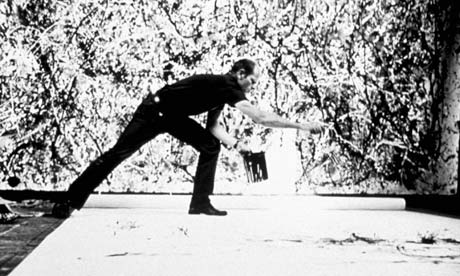
One day towards the end of his short life, Jackson Pollock called his wife, Lee Krasner, into his studio, pointed at the canvas on the floor and asked her: "Is that a painting?" It's a question that still does the rounds. When Whistler unveiled a near abstract picture of a firework display in Battersea Park, Ruskin accused him of "flinging a pot of paint in the public's face". So what to make of a man who really did find fame by hurling paint in the air?
Pollock was the most abstract of the abstract expressionists. It takes little effort to deduce landscapes and seascapes in Mark Rothko's numinous shimmers, and even the most diehard representationalist can be taught to see that Clyfford Still's paintings might – just – be representations of storm clouds or craggy mountainsides. But Pollock's work remains ineffable. Seen in small-scale reproduction, Lavender Mist (1950) could be mistaken for a Google Earth map. Seen up close, it can't be read as anything but itself – a vast, breathing matrix of nets and nodes all aquiver with transcendental longing. The only place a map like this takes you is down the royal road to the unconscious.
As Evelyn Toynton's reminds us, though, Pollock was less a Freudian than a Jungian: a destructive depressive, he underwent analysis that put the emphasis not on childhood and sex but on spiritual wellbeing and the cosmic soul. Though he started out as a surrealist, he had no hopes that the lines and loops of his "automatic" drawing might subconsciously coalesce into coherent images. The accidents of creation were enough for him. Not that he was any kind of rarefied romantic. Certainly he wasn't precious about his work. When Peggy Guggenheim commissioned him to make a painting to fit one wall of her apartment, Pollock got the measurements wrong. When Marcel Duchamp – who wΩas helping him hang the picture – said they'd have to take eight inches off, Pollock just reached for the scissors. Though we think of him swaggering gaily around his canvases, prints from his hobnailed boots can be seen all over the paintings. Often, says Toynton, you'll find "detritus from the studio… cigarette ends, matches, nails, tacks" stuck in there too. Paintings like Autumn Rhythm (1950) and Blue Poles (1952) have been subject to reams of high-flown hermeneutic flummery. But we would do well to remember that Pollock's work was never far from the trash and trample of the workshop floor.
A mean and mouthy drunk, Pollock spent more than one night with his head in the gutter after picking another fight he was way too small to win. Like Hemingway before him, and like Brando after, he could never quite accept that art was any kind of a way for a man to make a living. Toynton candidly admits that she can't be sure whether the story about Pollock taking a leak in the fireplace at one of Guggenheim's parties is true, but she knows such macho posturing would hardly have been out of character.
The more horrifying the world, Paul Klee once said, the more abstract the art. But while efforts to read Pollock's work as neurotic visions of the post-Hiroshima nightmare have never rung true, there is no denying that he came of age as a painter at the right time. Just as cubism had unconsciously found a way of objectifying the dilated space and time of Einstein's universe, so Pollock's vision embodied the fissile indeterminacy of the quantum world. Like all great abstractionists, he was more concrete than he knew. "I am nature," Pollock was fond of saying, and who could deny that for a few brief moments, prancing around, paint pot in hand, he was in tune with something far bigger than himself?

